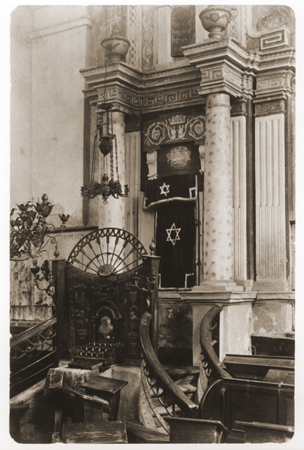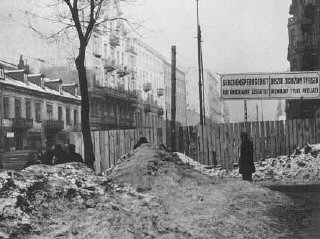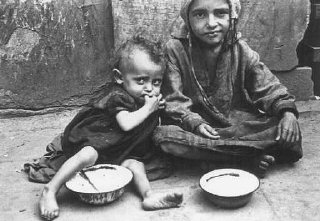Holocaust Education & Archive Research Team |
Ghettos
Introduction to the Ghettos of the Holocaust
Jewish Ghettos The Judenrat Judenrat Leaders Prominent Jews
| |||
The Chaim Kaplan Diary Selected Extracts
Chaim Aaron Kaplan was born in a village called Horodyszcze near Baranovichi, today it is the town of Gorodische in Belarus in 1880. He received a Talmudic education at the famous Yeshiva of Mir and later studied at the Government Pedagogical Institute in Vilna.
In about 1902 he settled in Warsaw, where he founded an elementary Hebrew school, of which he was the principal for the next forty years. He visited America in 1921 and Palestine in 1936 and published a number of books including a Passover Haggadah for children.
He kept a detailed personal diary starting in 1933 written in Hebrew, which is one of the rare original documents of its kind that has survived the Nazi era. It describes the decline of Jewish Warsaw and the holocaust period in general, the diary as Kaplan put it became my soul brother, my colleague and companion.
Until the beginning of the Second World War it was a private personnel account, but when the war erupted the diary changed its character and in addition to his own experiences and troubles, Kaplan recorded the story of the Jews of Warsaw, his own speculations on future developments, the behaviour and policies of the Germans as they unfolded before his eyes, and his opinions about the Poles.
Chaim Kaplan had a penetrating mind and a sharp eye and his diary faithfully reflects the events of most of the ghetto’s existence. The War diary begins on the 1 September 1939 and ends on the 4 August 1942, during the height of the mass deportation of the Warsaw ghetto to the Treblinka death camp.
Selected extracts from his diary:
1 September 1939
“This war will indeed bring destruction upon human civilisation. But this is a civilisation which merits annihilation and destruction. There is no doubt that Hitlerian Nazism will ultimately be defeated, for in the end the civilised nations will rise up to defend the liberty which the German barbarians seek to steal from mankind.
However, I doubt that we will live through this carnage. The bombs filled with lethal gas will poison every living being, or we will starve because there is no means of a livelihood.”
26 October 1939
“In our scroll of agony, not one small detail can be omitted. Even though we are now undergoing terrible tribulations and the sun has grown dark for us at noon, we have not lost our hope that the era of light will surely come.
Our existence as a people will not be destroyed, but the Jewish community will live on. Therefore, every entry is more precious than gold, so long as it is written down as it happens, without exaggerations or distortions.”
30 December 1939
“The poor ones fill the synagogues, which have become refugee centres. One cannot describe the crowded conditions, the congestion and filth in these centres.”
24 October 1940
“Will it be a closed ghetto? There were signs in both directions, and we hope for a miracle – which doesn’t always happen in time of need. A closed ghetto means gradual death. An open ghetto is only a halfway catastrophe.”
Kaplan describes the morning of the deportation of Jews from the nearby town of Pruszkow in January 1941
31 January 1941
“The exiles were driven out of their beds before dawn, and the Fuhrer’s minions did not let them take money, belongings or food, threatening all the while to shoot them.
Before they left on their exile, a search was made of their pockets and of all hidden places in their clothes and bodies. Without a penny in their pockets or a covering for the women, children, old people, and invalids – sometimes without shoes on their feet or staffs in their hands – they were forced to leave their homes and possessions and the graves of their ancestors , and go –wither?
And in terrible, fierce, unbearable cold.” On the morning of 17 November 1941 Warsaw Jewry was shocked to learn of the death sentence carried out on eight Warsaw Jews, for leaving the ghetto without permission:
17 November 1941
“One of the victims, a young girl not quite eighteen, asked the Jewish policeman who was present at the execution to tell her family that she had been sent to a concentration camp and would not be seeing them for some time.
Another young girl cried out to God imploring Him to accept her as the expiatory sacrifice for her people and to let her be the final victim.”
7 April 1942
We tremble at the mention of Lublin. An entire community of 44,000 Jews was plucked out by the roots and slaughtered or dispersed. Thousands of Jews were rounded up and led – where? Nobody knows.
According to rumour they were taken to Rawa Ruska and were electrocuted there. On Friday 17 April 1942 the Gestapo entered the ghetto and massacred 52 people, some members of the Underground, some who worked for Gancwajch, in what was called “The Night of Blood” or the “Bartholomew’s Night.”
17 April 1942
“At Nowolipki Street a man by the name of Goldberg was killed. He was a barber in peacetime, and when the war broke out he went to work in the quarantine house. His wife worked there too.
When he was killed, his wife set up a terrible wailing and would not leave his side. To silence her, they killed her too. Both were left lying by the gate. In death, as in life they remained inseparable.
The baker, David Blajman, on Gesia Street, was murdered in the same way. They came to take the husband but the frantic wife ran after him. To rid themselves of this hindrance, the murderers killed her along with her husband.
The morning light revealed both bodies at the gate. At 52 Leszno Street, Linder was killed. At number 27 on the same street a father and son were killed. So it went down to the last victim.”
16 June 1942
A catastrophe will befall us at the hands of the Nazis and they will wreak their vengeance on us for their final downfall. The process of physical destruction of Polish Jewry has already begun. Not a day goes by that the Nazis do not conduct a slaughter.
The rumours that reach us from the provincial towns are worse than the tidings of Job.
10 July 1942
It has been decreed and decided in Nazi ruling circles to bring systematic physical destruction upon the Jews of the General Government. The killing of thousands of people has turned into a business that employs many hands. After the souls expire, they strip the corpses.
Their clothing, shirts, and shoes are not wasted, but are collected in piles upon piles and turned over for disinfection, mending and repairs. Hundreds of Jews are employed in these tasks.
22 July 1942
I haven’t the strength to hold a pen in my hand. I’m broken, shattered. A whole community of 400,000 people condemned to exile.
30 July 1942
The seventh day of the expulsion. Living funerals pass before the windows of my apartment – cattle trucks or coal wagons full of candidates for expulsion and exile, carrying small bundles under their arms.
Their cries and shrieks and wails, which rent the very heavens and filled the whole area with noise, have already stopped. Most of the deportees seem resigned to their fate. Kaplan evidently made his final entry a day or two before his own deportation to Treblinka, it read:
“When my end comes – what will happen to the diary?” Chaim Kaplan and his wife are believed to have perished in Treblinka death camp.
Kaplan’s war diary was discovered almost intact after the war on a farm outside Warsaw, preserved in a kerosene can, the notebooks were legible and in good condition.
The diary was published in Hebrew and in two English editions. The Hebrew edition was called Megilat Yisurin Yoman Geto Varsha – Sept 1 1939 – August 4 1942.
The second contains all the pages of the diary that were recovered and was called “The Warsaw Diary of Chaim A Kaplan, New York 1965, 1973.
Sources:
Scroll of Agony – The Warsaw Diary of Chaim A. Kaplan. Indiana University Press, Bloomington and Indianapolis, 1999 The Holocaust by Sir Martin Gilbert published by Collins London 1986 The Jews of Warsaw 1939 -1943 by Yisrael Gutman, published by The Harvester Press Brighton 1982 Action Reinhard Camps – The Genuine ARC Website – www.deathcamps.org USHMM
Copyright Chris Webb & Tommy Charles H.E.A.R.T 2008
|




